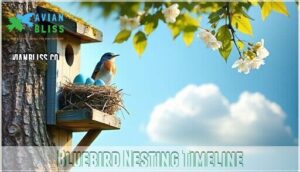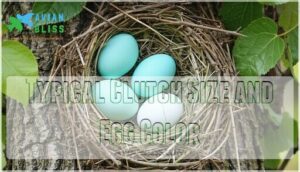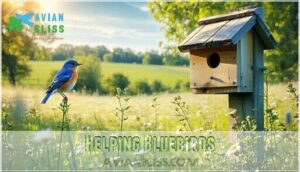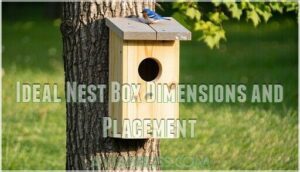This site is supported by our readers. We may earn a commission, at no cost to you, if you purchase through links.

The female does all the construction work, weaving grasses into a cozy cup. She’ll lay 2-7 pale blue eggs (occasionally white) and incubate them solo for about two weeks.
These cavity nesters aren’t picky about real estate, but they’re particular about timing.
Spring brings the first brood, often followed by a second round in summer.
Understanding their nesting preferences becomes your ticket to attracting these azure beauties to your backyard, but there’s more to their story than meets the eye.
Table Of Contents
- Key Takeaways
- Where Do Eastern Bluebirds Nest?
- Bluebird Nesting Timeline
- Bluebird Egg Characteristics
- Bluebird Nest Abandonment
- Unhatched Bluebird Eggs
- Bluebird Nesting Locations
- Bluebird Brood Size and Family Dynamics
- Helping Bluebirds
- Eastern Bluebird Nest Construction
- Frequently Asked Questions (FAQs)
- What month do bluebirds lay their eggs?
- Do bluebirds come back to the same nest every year?
- What does it mean when a bluebird hangs around your house?
- Do Bluebirds build nests?
- When do bluebirds start nesting?
- How do bluebirds find a nesting site?
- Do eastern bluebirds have interesting nesting habits?
- How long do baby bluebirds stay in the nest?
- Do bluebirds sleep with their eggs at night?
- Do bluebirds reuse nesting materials from previous seasons?
- Conclusion
Key Takeaways
- You’ll find bluebirds nesting exclusively in cavities – they can’t dig their own holes, so they depend on abandoned woodpecker sites or nest boxes you provide, with 77% choosing natural cavities over artificial ones.
- Female bluebirds handle all construction and incubation duties – they’ll weave grasses into cup-shaped nests in 4-5 days, then lay 4-5 pale blue eggs and incubate them solo for 12-14 days while males guard the territory.
- Proper nest box placement dramatically affects success rates – you’ll want boxes 5-6 feet high, facing east, with 1.5-inch entrance holes and 100-yard spacing to respect territorial boundaries.
- Bluebirds typically raise 1-3 broods per year – southern populations often manage three cycles from February through August, while northern birds usually complete two successful nesting cycles during favorable conditions.
Where Do Eastern Bluebirds Nest?
You’ll find Eastern bluebirds nesting exclusively in cavities, whether natural tree holes or artificial nest boxes you provide.
These cavity-nesters can’t excavate their own holes, so they depend on abandoned woodpecker sites or human-made alternatives to raise their families.
Natural Cavities Vs. Artificial Nest Boxes
Eastern bluebirds are cavity nesters who’ll use whatever works best.
Natural cavities like abandoned woodpecker holes make up 77% of their choices, but they’re equally happy with artificial nest boxes you provide.
These adaptable birds don’t discriminate – whether it’s a tree hollow or your carefully placed nest box, they’ll call it home if it meets their nesting needs.
Understanding their nesting habits is essential for effective conservation efforts.
Rare Exceptions to Cavity Nesting
While cavity nesters by nature, Eastern Bluebirds occasionally break their own rules when circumstances demand flexibility.
Adaptability becomes survival when traditional options disappear—nature’s ultimate backup plan.
These rare exceptions showcase their remarkable adaptability when traditional nesting sites become scarce.
Here are four documented exceptions to typical cavity nesting behavior:
- Ground Nesting: Observed in areas with severe cavity shortages, bluebirds construct nests directly on the ground, though this exposes them to increased nest predators and brood parasitism risks.
- Tree Cavities in Unusual Locations: Some pairs select extremely low cavities or those facing unusual directions when standard options aren’t available.
- Rock Crevices: In mountainous regions, bluebirds occasionally utilize natural rock formations and cliff faces for nesting, mimicking their Mountain Bluebird cousins.
- Burrow Nesting: Rarely documented instances show bluebirds attempting to nest in abandoned rodent burrows or similar ground-level openings.
These exceptions typically occur when habitat loss limits traditional nest boxes and natural cavities.
While fascinating from a behavioral standpoint, such unconventional bluebird nesting attempts usually result in lower success rates due to increased exposure to weather and predation.
Importance of Proper Nest Box Placement
Proper nest box placement substantially impacts bluebird nesting success rates.
Nest Box Height should be 5-6 feet above ground, providing predator protection while allowing easy monitoring.
Box Orientation facing east captures morning sunlight, warming nestlings efficiently.
Entrance Size measuring 1.5 inches prevents house sparrow competition while accommodating bluebirds.
Nesting boxes require 100-yard spacing to respect territorial boundaries.
| Placement Factor | Specification |
|---|---|
| Height | 5-6 feet above ground |
| Orientation | East-facing entrance |
| Spacing | 100 yards between boxes |
Box Material should be untreated wood with proper ventilation holes.
Nesting Depth of 4-5 inches below entrance prevents overcrowding while maintaining security for successful bluebird nesting.
Bluebird Nesting Timeline
You’ll want to understand the precise timing of bluebird nesting to monitor nest boxes effectively or simply appreciate these cavity nesters in your yard.
Eastern bluebirds follow a predictable schedule from territory establishment through fledging, with timing varying by geographic location and weather conditions.
When Do Bluebirds Start Building Nests?
Timing varies dramatically by location.
Southern bluebirds begin nest construction in February and March, while their northern counterparts start in March through late April.
This nesting season timing directly correlates with local climate conditions and food availability.
Bird nesting behavior shows males scout potential sites first, but females handle actual nest construction.
Nesting boxes placed early increase success rates for these enthusiastic bluebird nesting pioneers.
Understanding bluebird nesting habits is vital for effective conservation efforts.
Female Nest Builder and Egg-Laying Timing
Female bluebirds handle nest building solo, taking 4-5 days to construct their tidy cup-shaped homes using grasses and fine materials.
Female bluebirds are master builders, crafting perfect cup-shaped nurseries in just days using nature’s finest materials.
Once she completes construction, egg laying begins 6-7 days later—typically one pale blue egg per morning until her clutch of 4-5 eggs is complete.
This precise timing guarantees favorable breeding conditions.
Incubation Period and Fledging
After eggs are laid, the incubation period begins in earnest. You’ll find that egg hatching occurs after 11-19 days, averaging 13 days across different regions. The female handles all bird egg incubation duties while her mate guards territory and delivers meals. Incubation stages progress steadily as she maintains ideal temperature and humidity.
Once chicks hatch naked and blind, the fledging time spans 17-21 days. During this brood care period, both parents work tirelessly feeding insects to their growing young. The entire process from incubation start to fledging takes roughly one month.
Nest safety becomes paramount during these vulnerable weeks. Here’s what makes this period so remarkable:
- Baby bluebirds consume up to 350 insects daily, growing from helpless hatchlings to flight-ready birds
- Parents make feeding trips every few minutes during peak daylight hours
- Young birds develop flight feathers and coordination skills that will serve them for life
The bird egg incubation period showcases nature’s precision timing, with synchronized hatching ensuring all siblings develop together before taking their maiden flights.
Bluebird Egg Characteristics
You’ll find that bluebird eggs are instantly recognizable by their distinctive pale blue color, though occasional white eggs do occur.
Female bluebirds typically lay 4-5 eggs per clutch and handle all incubation duties for 12-14 days while males guard the territory.
Typical Clutch Size and Egg Color
You’ll find Eastern Bluebirds typically produce 4–5 eggs per clutch, though clutch size ranges from 2–7 eggs depending on breeding habits and environmental conditions.
Most bluebird egg colors are pale blue, but approximately 4–5% of clutches contain white eggs, and less than 1% are pink. The blue pigmentation comes from biliverdin deposited during formation.
All eggs within a clutch maintain uniform coloration – you won’t find mixed egg colors in bluebirds nests. Egg shapes are elliptical, measuring 0.7–0.9 inches long.
Larger clutches often occur at northern latitudes, contributing to nesting success rates across Eastern Bluebird populations. Eastern Bluebirds often engage in bird nesting habits that involve careful selection of nesting sites to guarantee the survival of their eggs.
Incubation Period and Female Incubation Duty
Once eggs are laid, incubation timing begins immediately when the female completes her clutch.
She shoulders the entire incubation responsibility alone, never leaving this critical female duty to chance.
For approximately 11-19 days, she maintains consistent warmth through dedicated brood care, ensuring ideal egg survival rates.
Meanwhile, her mate guards territory and delivers meals, supporting their nesting success through this partnership.
The bird egg incubation period varies by climate—warmer regions see shorter bluebird incubation periods, while northern areas extend the timeline.
This specialized bird incubation responsibilities system maximizes hatching success, with synchronized egg incubation producing simultaneous hatching.
Egg Size and Shape Compared to Robin Eggs
When you examine bluebird eggs next to robin eggs, you’ll notice striking differences in egg dimensions and color.
Bluebird eggs measure 0.8" x 0.7", making them slightly larger with thicker shells.
Their yolk size fills more of the egg shape, creating a rounder appearance.
While robins lay pale blue eggs, bluebirds produce deeper sky-blue eggs with richer pigmentation, making clutch comparison easy for birdwatchers.
Bluebird Nest Abandonment
You won’t always see successful nests—sometimes bluebirds abandon their carefully built homes for compelling reasons.
Understanding why this happens can help you better monitor nest boxes and make informed decisions about when to intervene.
Most Common Reasons for Abandonment
Understanding what drives bluebirds to abandon their nests helps you better support these cavity nesters.
Mate death ranks as the primary cause—particularly when females perish during incubation.
Predator attacks from cats, raccoons, or snakes create ongoing harassment that forces abandonment.
Extreme weather disrupts incubation temperatures, while food scarcity prevents adequate provisioning.
Unviable or infertile eggs also trigger nest abandonment as parents recognize failed reproduction efforts.
Timing Matters: Outcomes of Parental Death
When a bluebird parent disappears, timing is everything for nest survival.
In the context of bluebird nesting, Parental Loss before hatching spells Nest Failure, as only females incubate eggs. Males keep watch and bring food, but they can’t warm the clutch.
If a parent dies after hatching, the surviving adult does its best, but Survival Rates drop sharply. The bird nesting season doesn’t allow much wiggle room for replacing lost mates, so Breeding Delays are common.
You’ll see these patterns play out in nature:
- **Females do all the incubating; males can’t fill this role.
- **Nest abandonment rises if the female dies during incubation.
- **Mortality Factors like predators or harsh weather increase risk.
- **Bird parenting is a tough job—timing and teamwork make all the difference.
Bluebird nesting behavior is a delicate dance with fate. Understanding abandoned birds nest scenarios can help explain why such events occur in nature.
What to Do With Unhatched Eggs
A clutch of unhatched bluebird eggs can feel like a puzzle in your backyard. Before you rush into Egg Disposal or Nest Removal, take a breath and watch for signs of activity.
If the adults are still tending the nest, resist the urge to intervene—bluebirds often handle egg abandonment and Nest Cleaning themselves. Sometimes, they’ll simply build a fresh nest right on top of the old, failed clutch.
If you’re sure the nest has been deserted for over 72 hours after the last chick hatched, you can gently remove the unhatched eggs as part of responsible Fledgling Care and habitat maintenance. For those curious about bird egg failure reasons, Egg Candling can sometimes reveal if the eggs were ever viable.
Always prioritize the birds’ natural behaviors and cycles when considering any action regarding bird egg nesting abandonment.
Unhatched Bluebird Eggs
You’ll occasionally find unhatched eggs in bluebird nests after the successful siblings have fledged.
About 17% of bluebird eggs typically fail to hatch due to factors like poor incubation, genetic defects, or environmental stress.
Parental Removal and New Nest Building
Following a failed nest abandonment, adult bluebirds won’t simply walk away from their investment. Instead, they’ll systematically remove unhatched eggs and begin nest removal activities. This parental care behavior triggers immediate nest reuse preparation for their next attempt.
Bluebird behavior during nest relocation includes:
- Heartbreak turns to hope – Parents channel grief into building anew
- Nature’s resilience shines – Second chances bloom from disappointment
- Instinct overrides emotion – Survival drives replace sorrow
- Fresh starts await – New foundations rise from old failures
During nesting season, this bird egg removal process happens within days. Parents construct new nests directly atop failed ones, transforming bird nesting boxes into multi-story nurseries. This bird nesting strategy maximizes their reproductive window. The bluebirds’ ability to adapt is influenced by their parental care habits.
Candling for Viability and Possible Causes of Egg Failure
When parent bluebirds can’t remove unhatched eggs themselves, you’ll need to check their viability using the candling technique. Hold the egg against a bright light in a dark room to examine embryo development inside.
Wait at least 5-7 days after the expected hatching period before checking egg viability.
Here’s what causes bird egg failure:
- Temperature extremes – Both overheating and chilling halt development
- Humidity problems – Low moisture causes membranes to stick to embryos
- Bacterial infections – Contamination kills developing chicks
- Genetic malformations – Natural developmental issues prevent hatching
During bird egg candling method, viable eggs show red blood vessels and movement. Failed eggs appear clear, discolored, or emit foul odors. Infertility factors account for only 17% of failures – most result from environmental impact during early development stages.
Leaving Unhatched Eggs Alone
When you discover unhatched eggs in a bluebird nest, resist the urge to interfere.
Nest monitoring shows that parent bluebirds handle egg removal naturally after brood failure. They’ll crush or discard non-viable eggs themselves within 72 hours of other chicks hatching.
| Scenario | Natural Response |
|---|---|
| Single unhatched egg | Parents remove within days |
| Complete clutch failure | Build new nest on top |
| Partial hatch success | Focus energy on live young |
| Egg abandonment | Abandon site entirely |
Your intervention disrupts their instinctive behavior and may compromise fledging success for remaining viable eggs.
Bluebird Nesting Locations
You’ll find bluebirds nesting in two primary locations: abandoned woodpecker cavities and properly placed nest boxes, with oak trees serving as particularly favored natural sites.
While these cavity nesters rarely deviate from their typical behavior, they occasionally nest in unusual spots like fence posts or even ground-level crevices when suitable cavities aren’t available, which can be considered an unusual behavior.
Abandoned Woodpecker Cavities and Nest Boxes
In abandoned woodpecker cavities and artificial nest boxes, bluebirds find their perfect homes.
These cavity nesters readily adapt to both natural and manmade structures, showing remarkable flexibility in cavity selection.
Woodpecker habits create ideal hollows that bluebirds inherit, while properly designed nesting boxes offer equally suitable alternatives.
Your nest box design should feature an 8-12 inch height with a 1.5-inch entrance hole, mimicking natural cavities perfectly for successful bluebird nesting.
Oak Trees as Common Nesting Sites
Oak trees stand as premium bluebird nesting sites across Eastern North America.
These cavity nesters favor oak woodlands where abandoned woodpecker holes provide perfect tree cavities.
Oak habitat offers ideal conditions with:
- Standing dead oaks (snags) containing multiple cavity options
- Heights ranging from 12-50 feet for ideal nest placement
- Open woodland structure supporting bluebird preference for accessible foraging
Forest ecology research confirms oaks consistently rank among top natural nesting sites for Eastern Bluebirds.
Rare Ground Nesting and Roosting Spots
Beyond traditional cavity nesters, bluebirds occasionally surprise researchers with unconventional choices.
Ground nesting occurs rarely when suitable cavities aren’t available, though these attempts face higher predation risks.
For roosting sites, bluebirds adapt readily—using empty nesting boxes, abandoned woodpecker holes, or natural tree crevices as overnight shelters.
| Nesting Location | Usage Frequency | Success Rate |
|---|
These rare habitats demonstrate bluebirds’ resourcefulness when traditional cavity options become scarce in their territories.
Bluebird Brood Size and Family Dynamics
You’ll discover that bluebirds typically raise one to three broods per year, with most pairs managing two successful nesting cycles during favorable conditions.
Eastern bluebirds form strong family bonds, and young birds from earlier broods often help their parents feed and protect later nestlings, creating a cooperative family structure that improves overall nesting success, which is a key factor in their nesting cycles.
One or Two Broods Per Year
Eastern Bluebirds typically raise two broods per breeding season, though southern populations often manage three.
Breeding seasons lasting from February through August provide ample opportunity for multiple brood frequency cycles. Early nesters enjoy higher nest success rates and better fledging rates.
Key factors affecting brood size include:
- Nest reuse patterns and seasonal timing
- Food availability during bird nesting cycles
- Weather conditions throughout bluebird nesting periods
- Previous nest success experience.
Bird broods depend heavily on when pairs begin their bird nesting cycles each spring.
Eastern Bluebird Family Bonds and Young Helpers
Family Dynamics create fascinating patterns when young Eastern Bluebird helpers remain with parents after fledgling.
These Young Helpers assist with Fledgling Care, feeding siblings and serving as Nest Guardians during bluebird breeding season.
This cooperative bird nesting habits system reduces Sibling Rivalry while improving survival rates through shared responsibilities in bird family dynamics.
| Helper Role | Age Range | Contribution |
|---|---|---|
| Food Provider | 25-40 days | Brings insects to nestlings |
| Territory Scout | 30-50 days | Alerts to predator threats |
| Nest Cleaner | 20-35 days | Removes waste from cavity |
| Sibling Mentor | 40-60 days | Teaches foraging techniques |
| Guard Duty | 25-45 days | Defends nesting territory |
Insect-Based Diet and Berry Consumption
Understanding bluebird nesting habits reveals fascinating Eastern Bluebirds dietary preferences that fuel successful reproduction.
These cavity nesters maintain specific feeding habits throughout their breeding cycle.
- Insect Food dominance – Beetles, caterpillars, and grasshoppers comprise 68% of their diet during nesting season
- Berry Nutrition supplementation – Wild cherries, elderberries, and sumac provide essential vitamins year-round
- Foraging Tips observation – They hunt from low perches, swooping to catch ground insects
- Diet Variety adaptation – Spiders, small fruits, and seeds round out their bird nesting requirements
This diverse menu supports strong bird egg characteristics and healthy chick development in bluebird nesting colonies.
Helping Bluebirds
You can actively support bluebird populations by providing proper nest boxes and maintaining suitable habitat in your area.
Creating bluebird-friendly spaces requires understanding their specific needs for open areas, proper nest box placement, and avoiding harmful pesticides that reduce their insect food sources, which is crucial for maintaining a healthy habitat.
Becoming a Volunteer Bluebird Monitor
Volunteering as a bluebird monitor transforms you into nature’s record-keeper, tracking these azure jewels through their nesting cycles. Your conservation efforts support Eastern Bluebirds while deepening your understanding of bluebird behavior.
To support bluebirds, consider installing bluebird nest boxes in your area.
| Monitor Responsibilities | Volunteer Training Focus |
|---|---|
| Weekly nest inspection visits | Identifying bluebird nesting stages |
| Recording clutch sizes and fledging rates | Recognizing threats to bird nesting sites |
| Maintaining detailed breeding records | Understanding bluebird habitat requirements |
This volunteer bluebird monitor role connects you directly with local conservation groups.
Providing Suitable Habitat and Food Sources
Set up bluebird habitat by creating the right mix of open spaces and food sources.
Your yard becomes a wildlife haven when you balance these elements thoughtfully.
- Plant native berry-producing shrubs like elderberry, dogwood, and sumac for winter sustenance
- Maintain short-grass areas with scattered perches for ground-dwelling insect hunting
- Provide shallow water sources through birdbaths or small ponds for drinking needs
- Eliminate pesticide use to preserve the insect-rich environment bluebirds require year-round
Installing Nest Boxes and Avoiding Pesticides
Strategic nest box placement creates bluebird havens in your yard. Position birdhouses for bluebirds 5-6 feet high, facing away from prevailing winds, with entrance holes toward open areas for maximum nesting site selection.
When designing a nest box, consider using proper nest box plans to guarantee the best results.
| Nest Box Requirements | Specifications |
|---|---|
| Height from ground | 5-6 feet |
| Entrance hole size | 1.5 inches diameter |
| Box maintenance schedule | Annual cleaning |
Avoid pesticides completely—they contaminate nesting material and eliminate insects bluebirds need for nest construction and feeding young in bird friendly gardens.
Eastern Bluebird Nest Construction
You’ll find that female Eastern Bluebirds are fastidious architects, weaving together fine grasses, pine needles, and small twigs to create their signature cup-shaped nests in just 4-5 days.
These resourceful birds often build new nests directly on top of old ones, making proper nest box maintenance essential for their continued success.
Cup-Shaped Nest and Female Builder
Female eastern bluebirds are skilled architects who construct their nest architecture independently. During nest building, females select specific nesting materials including fine grasses, pine needles, and occasionally feathers to create the characteristic cup shape.
The female behavior demonstrates remarkable precision in nest construction:
- She gathers materials within a 100-yard radius of the nesting site
- Weaves grasses into a tight, shallow cup measuring 3-4 inches across
- Lines the interior with softer materials for cushioning eggs
- Completes bird nests in 4-5 days under favorable conditions
This cup-shaped design provides ideal protection for eggs while maintaining proper ventilation. The female’s methodical approach to bluebird nests guarantees structural integrity throughout the breeding season.
New Nests on Top of Old Ones
Bluebirds stack new nests right on top of old ones, creating multi-story structures within their chosen cavity.
This nest reuse strategy demonstrates efficient bluebird behavior as parents maximize familiar nesting sites.
While this nest construction method saves energy, old nest removal becomes essential for nest box maintenance since accumulated materials can attract parasites and predators to these recycled nesting strategies.
Understanding nesting habits is essential for effective conservation and support of these birds.
Ideal Nest Box Dimensions and Placement
When building nest boxes for bluebirds, proper dimensions create ideal nesting sites for these cavity-nesters.
Your box material should be untreated cedar or pine for durability. Here are key specifications:
- Floor size: 4×4 to 5×5 inches provides adequate space
- Nest Box Height: 8-12 inches from floor to roof
- Entrance Size: 1.5-inch diameter hole positioned 5-7 inches above floor
- Mounting Options: Install 4-6 feet high facing east, avoiding direct sun exposure
Proper birdhouses with drainage holes and ventilation guarantee successful bird nesting seasons.
Using a Bluebird Nest box design can help attract these birds to your yard.
Frequently Asked Questions (FAQs)
What month do bluebirds lay their eggs?
When spring’s warmth awakens dormant instincts, you’ll witness nature’s precise timing unfold.
Bluebirds typically lay eggs from February through April, with southern populations starting earlier and northern birds waiting until March or April for ideal conditions.
Do bluebirds come back to the same nest every year?
No, they don’t return to the exact same nest annually.
Bluebirds may reuse successful nests within a season or build new ones on top of old structures, but they typically construct fresh nests each breeding year.
What does it mean when a bluebird hangs around your house?
A bluebird lingering near your home likely indicates you’re in prime habitat with open areas, suitable nesting sites, and abundant insects for foraging opportunities.
Do Bluebirds build nests?
Yes, female bluebirds build nests using fine grasses, weeds, and twigs. Construction takes 4-5 days on average, creating tidy cup-shaped structures in cavities like nest boxes or old woodpecker holes.
When do bluebirds start nesting?
You’ll notice activity starting as early as late February in southern regions, with northern bluebirds beginning their search for suitable cavities in March.
Males establish territories first, then attract mates for nesting.
How do bluebirds find a nesting site?
Remarkably, 77% of bluebirds use natural woodpecker cavities over artificial nest boxes.
Males scout potential sites within their territory, then perform courtship displays at each location.
You’ll see females carefully inspecting multiple options before choosing the perfect spot for their family’s future home.
Do eastern bluebirds have interesting nesting habits?
Males scout territories and present potential nest sites to choosy females, who’ll build cup-shaped nests in cavities.
They’re remarkably adaptable, using everything from woodpecker holes to your backyard nest boxes fifty feet high, which showcases their ability to thrive in various environments with choosy females.
How long do baby bluebirds stay in the nest?
Like tiny feathered prisoners breaking free, baby bluebirds spend 17-21 days in their nest before fledging.
You’ll notice they’re ready to leave when their flight feathers develop fully and they can survive independently outside.
Do bluebirds sleep with their eggs at night?
Yes, female bluebirds sleep on their eggs at night during incubation.
She’ll stay put on the nest, keeping those precious blue treasures warm and cozy through the darkness while dad stands guard nearby.
Do bluebirds reuse nesting materials from previous seasons?
Bluebirds don’t typically reuse old nesting materials from previous seasons. They’ll build fresh nests using new grasses, twigs, and pine needles, though they might construct new nests atop old ones.
Conclusion
Understanding bluebirds nests and eggs transforms you from casual observer to informed steward of these cavity-dwelling gems.
You’ve learned their timeline—spring construction through summer fledging—and discovered why proper nest box placement matters more than luck.
When you spot those signature pale blue treasures nestled in grass-woven cups, you’ll recognize the female’s dedicated two-week vigil ahead.
Armed with knowledge about abandonment triggers and unhatched egg protocols, you’re ready to support these azure beauties while respecting their natural rhythms throughout their remarkable nesting journey.















